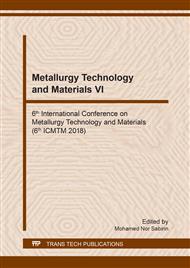p.35
p.44
p.49
p.55
p.60
p.67
p.72
p.77
p.85
Diffusion Behavior and Wear Mechanism of WC/Co Tools when Machining of Titanium Alloy
Abstract:
In this paper, fine-grain WC/Co tools were utilized in dry turning of the Ti-6Al-4V alloy. The wear modes of the cutting tools at different cutting speeds were analyzed. The diffusion behavior between the cutting tool and the workpiece was studied in detail based on the Auger electron spectroscopy (AES) depth profile technology. The diffusion wear mechanism was revealed. The results showed that the diffusion layer formed at the interface between the cutting tool and the adhering material. The diffusion ability of C was the strongest, followed by W, the weakest was Co in all the elements of the cutting tool. The chemical reactions took place close to the adhering material, forming the reaction layer. As a diffusion barrier, it was possible to limit the elements diffusion from the cutting tool to the adhering material, decrease the changes in the cutting tool composition and damages. The diffusion layer, which was weakened by diffusion, was worn off and taken away by the fast flowing chip during the cutting process, causing the diffusion wear characterized by a smooth crater formation on the tool surface.
Info:
Periodical:
Pages:
60-66
Citation:
Online since:
August 2018
Authors:
Price:
Сopyright:
© 2018 Trans Tech Publications Ltd. All Rights Reserved
Share:
Citation:


